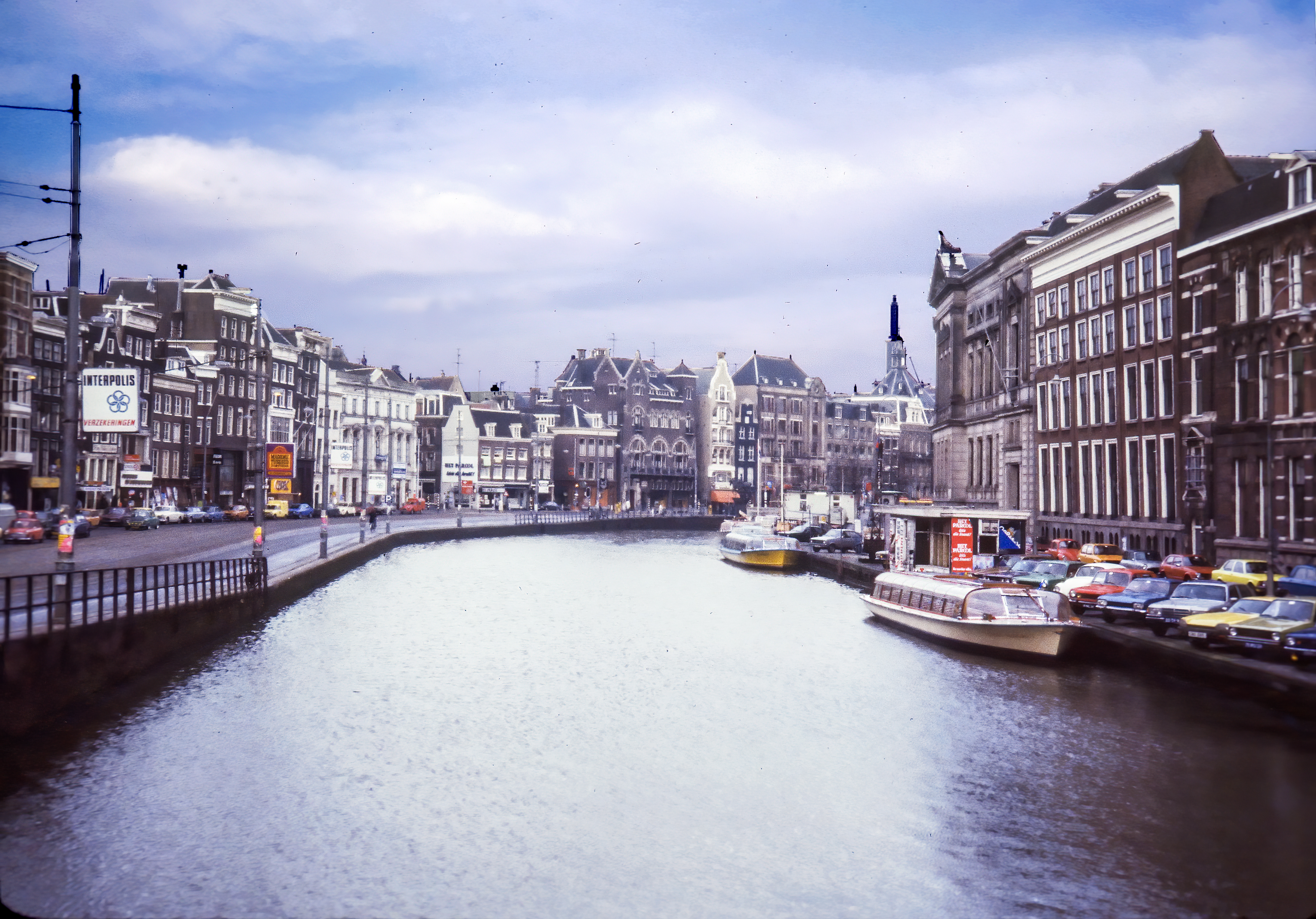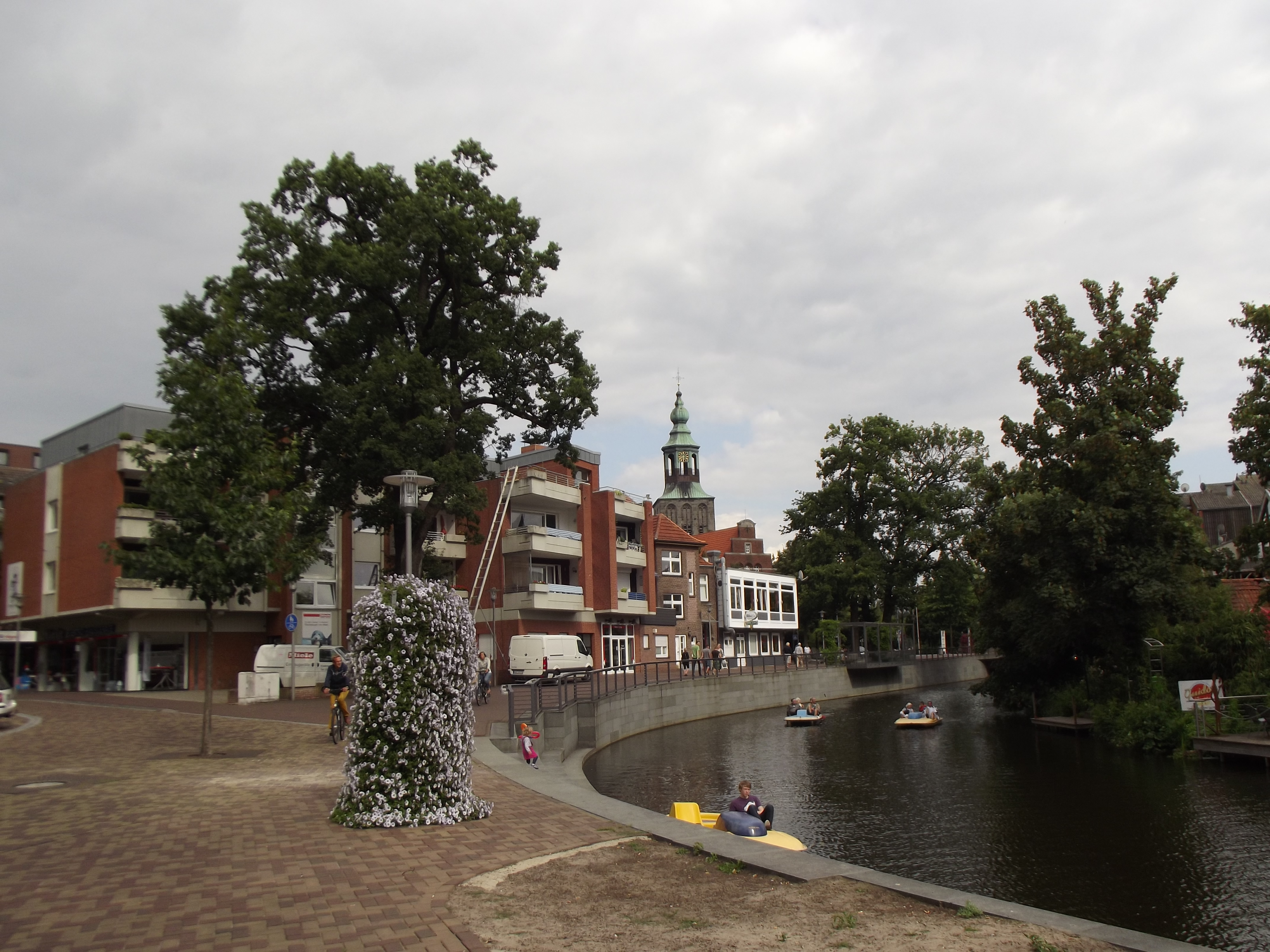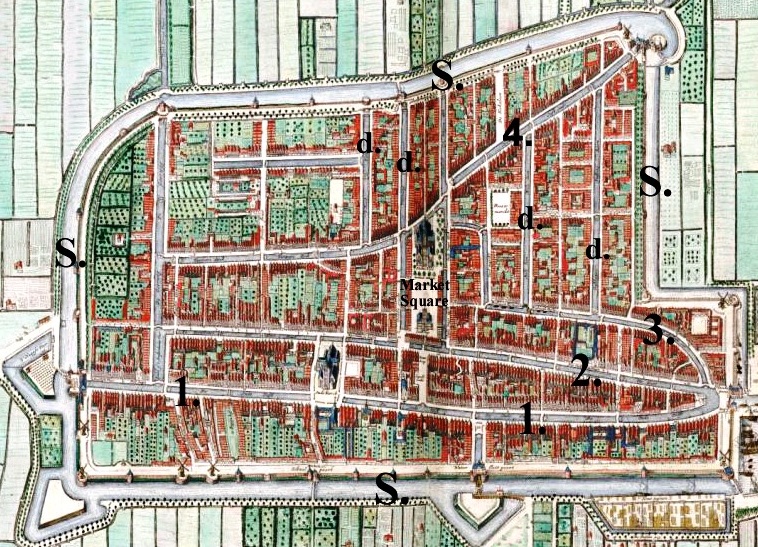Gracht in the centre of watertown Nordhorn.jpg on:
[Wikipedia]
[Google]
[Amazon]
''Gracht'' (; plural: ''grachten'') is a Dutch word for a canal within a city.
''Grachten'' often have a round shape, and form a circle around the city cores in the Netherlands, Belgium, and northern Germany. Outside the Netherlands, the word ''grachten'' mostly refers to the city canals of Amsterdam (for which it is well known) and also Utrecht, Leiden and The Hague. The Koninginnegracht in The Hague was conceived by King Willem I for the promotion of tourism in the early 19th century. Since 2009 the Willemsvaart once more offers tours over this ''gracht'', to Scheveningen, known as "StrandRelax" or "BeachRelax", a unique stretch of sand between The Hague and the sea.


 The word ''gracht'' cannot be easily
The word ''gracht'' cannot be easily
 The word ''gracht'' stems from the older word ''graft'', which is derived from ''graven'', to dig (cf. English " grave"). The Dutch language has had a sound shift in which the combination -ft became -cht. Other examples are ''lucht'' (German: ''Luft'', air) and ''zacht'' (English: soft). In some regional languages such as Frisian and Gronings, the word ''graft'' is still used.
In Dutch, the word ''gracht'' is used only when canals are located inside the city, while canals outside a city are called ''kanaal''. However,
The word ''gracht'' stems from the older word ''graft'', which is derived from ''graven'', to dig (cf. English " grave"). The Dutch language has had a sound shift in which the combination -ft became -cht. Other examples are ''lucht'' (German: ''Luft'', air) and ''zacht'' (English: soft). In some regional languages such as Frisian and Gronings, the word ''graft'' is still used.
In Dutch, the word ''gracht'' is used only when canals are located inside the city, while canals outside a city are called ''kanaal''. However,
voorbeginners.info
speaks of "kanalen" not of "grachten" when it describes Venice in Dutch.
 Most Hanseatic cities have ''grachten'' to transport, to load and to land goods in and from ships. In the Netherlands, the northeastern cities of
Most Hanseatic cities have ''grachten'' to transport, to load and to land goods in and from ships. In the Netherlands, the northeastern cities of
File:Holland and the Hollanders - Amsterdam - the Heeren Gracht.png, Heerengracht in 1872
File:Dordrecht Pelserbrug.jpg, Dordrecht
File:Leidsevaart Haarlem.jpg,
Translation


 The word ''gracht'' cannot be easily
The word ''gracht'' cannot be easily translated
Translation is the communication of the meaning of a source-language text by means of an equivalent target-language text. The English language draws a terminological distinction (which does not exist in every language) between ''transla ...
; for this reason, it is necessary to distinguish between four related terms:
* A ' (city-canal) is a waterway in the city
A city is a human settlement of notable size.Goodall, B. (1987) ''The Penguin Dictionary of Human Geography''. London: Penguin.Kuper, A. and Kuper, J., eds (1996) ''The Social Science Encyclopedia''. 2nd edition. London: Routledge. It can be def ...
with one-way street
A street is a public thoroughfare in a built environment. It is a public parcel of land adjoining buildings in an urban context, on which people may freely assemble, interact, and move about. A street can be as simple as a level patch of dirt, ...
s on both sides of the water. The streets are lined with house
A house is a single-unit residential building. It may range in complexity from a rudimentary hut to a complex structure of wood, masonry, concrete or other material, outfitted with plumbing, electrical, and heating, ventilation, and air condi ...
s, often in a closed front. In rare cases, there is only one street, and on the other side of the waterway, the houses border on the water.
* A ' (literally meaning canal) is a man-made watercourse, usually in the countryside, with or without streets along its banks.
* A ' is a canal used for transport, rather than for other purposes such as drainage. Like most ''kanalen'', they are usually in the countryside.
* A ' is by origin a water-filled moat
A moat is a deep, broad ditch, either dry or filled with water, that is dug and surrounds a castle, fortification, building or town, historically to provide it with a preliminary line of defence. In some places moats evolved into more extensive ...
which surrounds a city for defense
Defense or defence may refer to:
Tactical, martial, and political acts or groups
* Defense (military), forces primarily intended for warfare
* Civil defense, the organizing of civilians to deal with emergencies or enemy attacks
* Defense industr ...
purposes. When the city expands, the singel is incorporated in the city's structure and can no longer be distinguished from a ''gracht'', but the name ''singel'' is usually maintained. As such, ''singel''s often encircle (older) parts of the city. However, in other cases regular ''grachten'' were dug in circles as well, like the famous Grachtengordel (literal translation: ''grachten'' belt) of Amsterdam.
Although the word ''gracht'' means "canal" or "waterway" in the general sense, there is no exact equivalent for the term in English.
Etymology
 The word ''gracht'' stems from the older word ''graft'', which is derived from ''graven'', to dig (cf. English " grave"). The Dutch language has had a sound shift in which the combination -ft became -cht. Other examples are ''lucht'' (German: ''Luft'', air) and ''zacht'' (English: soft). In some regional languages such as Frisian and Gronings, the word ''graft'' is still used.
In Dutch, the word ''gracht'' is used only when canals are located inside the city, while canals outside a city are called ''kanaal''. However,
The word ''gracht'' stems from the older word ''graft'', which is derived from ''graven'', to dig (cf. English " grave"). The Dutch language has had a sound shift in which the combination -ft became -cht. Other examples are ''lucht'' (German: ''Luft'', air) and ''zacht'' (English: soft). In some regional languages such as Frisian and Gronings, the word ''graft'' is still used.
In Dutch, the word ''gracht'' is used only when canals are located inside the city, while canals outside a city are called ''kanaal''. However, Venice
Venice ( ; it, Venezia ; vec, Venesia or ) is a city in northeastern Italy and the capital of the Veneto Regions of Italy, region. It is built on a group of 118 small islands that are separated by canals and linked by over 400 ...
is an exception. In Dutch, one does not say "''de grachten van Venetië''" (the city-canals of Venice), but "''de kanalen van Venetië''" (the canals of Venice).Tourist guidvoorbeginners.info
speaks of "kanalen" not of "grachten" when it describes Venice in Dutch.
Toponyms
Toponymy, toponymics, or toponomastics is the study of ''toponyms'' (proper names of places, also known as place names and geographic names), including their origins, meanings, usage and types. Toponym is the general term for a proper name of ...
for grachten are usually made by the suffixes ''-gracht'', ''-singel'' (which refers to the old circle-shaped canals), ''-wal'' (referring to the bank of the gracht), ''-vest'' (referring to a fortification), and ''-kade'' ( Southern Dutch: ''-kaai''; quay). The suffix ''-diep'' is used in Groningen where it is a local word for a large canal.
When a ''gracht'' is a remake of an old river, the river's name is used.
History
''Grachten'' were the life-lines of Dutch and Flemish cities. They were used for many purposes: for transportation, for draining, as water supply and as sewers, all at the same time. In heavily populated cities, these combined functions repeatedly proved to be detrimental to the public health. Most Hanseatic cities have ''grachten'' to transport, to load and to land goods in and from ships. In the Netherlands, the northeastern cities of
Most Hanseatic cities have ''grachten'' to transport, to load and to land goods in and from ships. In the Netherlands, the northeastern cities of Deventer
Deventer (; Sallands: ) is a city and municipality in the Salland historical region of the province of Overijssel, Netherlands. In 2020, Deventer had a population of 100,913. The city is largely situated on the east bank of the river IJssel, bu ...
, Hindeloopen, Kampen
Campen or Kampen may refer to:
Places Finland
* Kampen, the Swedish name of Kamppi, a district in Helsinki
Germany
* Campen, Germany, a village by the Ems estuary, northwestern Germany, home of the Campen Lighthouse
* Campen Castle, a part ...
, Leeuwarden, Meppel
Meppel (; Drents: ''Möppelt'') is a city and municipality in the Northeastern Netherlands. It constitutes the southwestern part of the province of Drenthe. Meppel is the smallest municipality in Drenthe, with a total area of about 57 km² (22 sq ...
, Sneek, Zutphen and Zwolle are renowned for their historical ''grachten''. Other cities in the Netherlands, in the western part of the country, are also touristic attractions because of their ''grachten'', especially Alkmaar
Alkmaar () is a city and municipality in the Netherlands, located in the province of North Holland, about 30 km north of Amsterdam. Alkmaar is well known for its traditional cheese market. For tourists, it is a popular cultural destination. The ...
, Amersfoort, Gouda
Gouda may refer to:
* Gouda, South Holland, a city in the Netherlands
** Gouda (pottery), style of pottery manufactured in Gouda
** Gouda cheese, type of cheese originally made in and around Gouda
** Gouda railway station
* Gouda, Western Cape, a s ...
, Hoorn
Hoorn () is a city and municipality in the northwest of the Netherlands, in the province of North Holland. It is the largest town and the traditional capital of the region of West Friesland. Hoorn is located on the Markermeer, 20 kilometers ( ...
, Leiden, Utrecht and Weesp.
Sometimes ''grachten'' were made from older rivers, like in Groningen
Groningen (; gos, Grunn or ) is the capital city and main municipality of Groningen province in the Netherlands. The ''capital of the north'', Groningen is the largest place as well as the economic and cultural centre of the northern part of t ...
. There the older river called Drentse Aa
The Drentsche Aa () is a river rising in the Dutch province of Drenthe, flowing through Drenthe and for the last part the province of Groningen. It ends in the Schipsloot near Haren, which flows into the Noord-Willemskanaal; however, originall ...
was used as a natural part of the grachten. In Delft
Delft () is a List of cities in the Netherlands by province, city and Municipalities of the Netherlands, municipality in the Provinces of the Netherlands, province of South Holland, Netherlands. It is located between Rotterdam, to the southeast, ...
, the main ''gracht'' – Oude Delft – started as a drainage canal for reclaiming land in marshy surroundings: in a period roughly around the year 1100, a canal was dug, making use of a natural creek in the marshy country. This canal was called ''Delf'', later on ''Delft'', from the word ''delven'' that is akin to the verb to "delve" in English. This canal was used to drain the land at both sides; later on it also served as a waterway for transport.
Later, a second canal, called the ''Nieuwe Delft'' (New Delft) was dug through part of the settlement that had grown around the first. The original canal became known as the ''Oude Delft'' (Old Delft), a name it still bears today.
The rural village around ''Oude'' and ''Nieuwe Delft'' developed into a more urban area and the canals gradually acquired the character of city-canals or ''grachten''. A third canal was dug and also changed into a ''gracht''; it connected with the moat around the marketplace. The city and the ''grachten'' grew hand in hand. In 1246, this agglomeration was granted a city charter by the Count of Holland
The counts of Holland ruled over the County of Holland in the Low Countries between the 10th and the 16th century.
House of Holland
The first count of Holland, Dirk I, was the son or foster-son of Gerolf, Count in Frisia (Dijkstra suggests th ...
and became the City of Delft. A natural waterway was later incorporated in the city and became a ''gracht'' as well. Circular canals or ''singels'' were dug and surrounded the city. Fortifications were built along these ''singels'' and fixed the shape of the historical inner city of Delft. The characteristic, narrow ''grachten'', perpendicular to the main ''grachten'', developed from ditches that had been dug to drain and delimit the fields which preceded the city.
When it was still a Dutch colony, Cape Town had a network of ''grachten'', that were fed by the springs at the base of Table Mountain. These provided water and sanitation for the infant town. In the ensuing centuries, the ''grachten'' were covered over, but many of the prominent streets in the modern city centre still bear their names (notably the Heerengracht, Keizersgracht, Buitengracht and Buitensingel). There is currently a project to restore some of these historic waterways.
A function in almost every city was drainage. Rainwater flowed through these city-canals. Usually they were also used as a sewer. Because these functions are not needed any more, many ''grachten'' have been filled in to give access to road traffic. However, these new streets have mostly retained the names of the ''grachts'' and ''singels'' they covered or replaced.
Haarlem
Haarlem (; predecessor of ''Harlem'' in English) is a city and municipality in the Netherlands. It is the capital of the province of North Holland. Haarlem is situated at the northern edge of the Randstad, one of the most populated metropoli ...
File:Leiden, de Marekerk RM25069 met de Marebrug foto7 2017-06-11 09.40.jpg, Leiden
File:Panoramic view of the Zwolle canals (Thorbecke gracht) with old ships and a nice sky - panoramio.jpg, Zwolle
References
{{Authority control Canals Water transport infrastructure Waterways in the Netherlands Dutch words and phrases